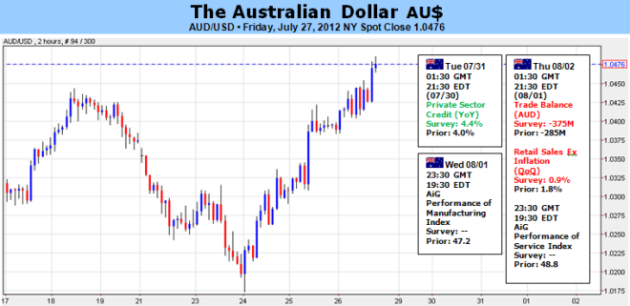
Fundamental Forecast for Australian Dollar: Bearish
- Key Channel Top, 1.05 Figure in Focus for AUDUSD Positioning
- Australian Dollar Outperforms on Firmer HSBC China PMI Print
- In-line CPI Leaves RBA Rate Outlook, Aussie Dollar Little Changed
The Australian Dollar remains firmly anchored to risk sentiment, with a trade-weighted index of the currency’s average value against its leading counterparts showing an iron-clad correlation with the MSCI World Stock Index. This puts global growth expectations front and center, turning the spotlight on the Federal Reserve and the European Central Bank as both deliver their monthly policy announcements in the week ahead.
Market-wide economic growth expectations pencil in a recession in the Eurozone and a narrow pickup in US performance in 2012. This means any added stimulus to be unveiled at these rate decisions speaks directly to mitigating the primary headwind facing the global recovery and amplifying its foremost offsetting force. While the ECB appears primed to offer a dose of further accommodation, hopes for the launch of a third round of Fed quantitative easing (QE3) are likely to be disappointed. On net, this seems likely to fall short of satiating investors, weighing on risk appetite and pulling the Australian Dollar broadly lower.
Turning first to the ECB, markets appear primed for another interest rate cut. Indeed, data from Credit Suisse suggests investors are pricing in an 82.5 percent probability of another 25bps reduction in the benchmark cost of borrowing. To deliver a meaningful boost to risk trends, the central bank will need to deliver above those expectations, and comments from ECB President Mario Draghi last week suggested just such an outcome may be in the works. Draghi warned that if swelling sovereign risk premia in bond yields disrupt monetary policy transmission, dealing with them falls within the ECB’s mandate. That hints the bank may reboot its bond-buying program, a boon for debt-strapped Eurozone countries squeezed by prohibitively high funding costs.
Meanwhile, the Federal Reserve is unlikely to offer the markets much more than the familiar yarn about the availability of QE3 in the event that it is necessary all the while opting to leave the levers of monetary policy unchanged from their current setting. Indeed, with yields across the maturity spectrum hovering within a hair of record lows having arrived there without any new stimulus since QE2 concluded in June 2011. It seems unreasonable to argue that more asset purchases are needed to keep credit costs capped or that marginally cheaper funding will bring a significant number of would-be borrowers off the sidelines. That means the most significant benefit of a QE3 program is to be found in a psychological boost to market sentiment. Ben Bernanke and company are likely to keep such a tool in the arsenal for the time being, to be unveiled in the event a major dislocation in Europe creates a global credit freeze akin to the 2008 debacle following the collapse of Lehman Brothers.
The domestic economic calendar is generally quiet, with Building Approval, Trade Balance and Retail Sales figures highlighting a docket of second-tier releases. The round-up of July’s HSBC-produced and official manufacturing- and service-sector Chinese PMI numbers may prove market-moving however. China is Australia’s top trading partner and its performance speaks directly to the health of the latter country’s mining sector, a core source of economy-wide strength over recent years.
0 comments:
Post a Comment